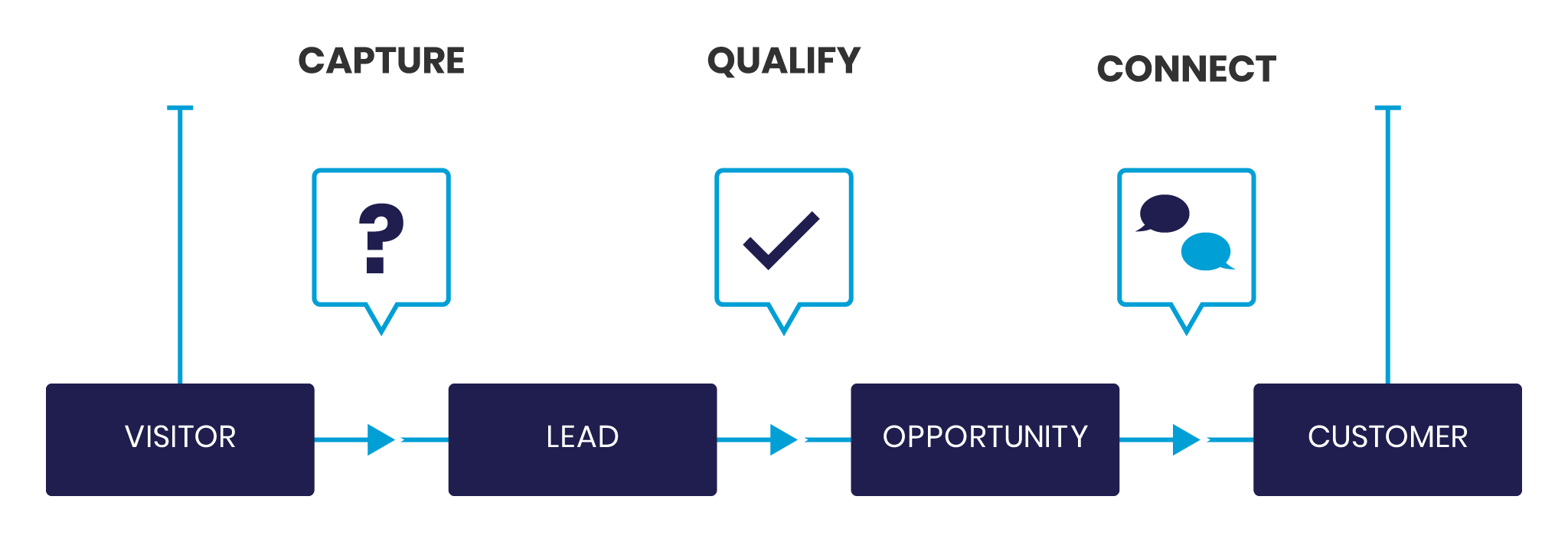


Why conversational marketing should be central to your 2018 strategy




People like to talk. People especially like to talk about themselves. They like to be asked questions and they like to know you're listening. It's one of the many things that makes us human, and a leading reason for the growing popularity of conversational marketing.
By the beginning of 2015, the big four messenger apps (Whatsapp, Messenger, WeChat and Viber) had surpassed the monthly active users of the big four social apps (Facebook, Instagram, Twitter and LinkedIn). They've become the main communication channels not just for Millennials and their understudies, Generation Z, but all the way up to the Boomers, too.
Excitingly, conversations are now moving from consumer-to-consumer to consumer-to-business. Here at Six & Flow, we're seeing our own clients develop a growing preference for real-time communications, be that through Slack or even WhatsApp.
Why it’s good to talk (especially on mobile)
But with that shift comes the same expectations. We want our conversations when we want them, not when you're ready to reply. Sales, support, general information… Your potential customers have questions and they want you to answer them, now. Chat - especially real-time chat - has fast become the centre of the mobile universe. Communication habits are changing, and so are our buying habits. Between 2015 and 2016, ecommerce purchases through WeChat more than doubled. It's a huge area of growth, especially in the mobile marketing sphere.
As a marketer or salesperson, a one-to-one or even in a one-to-few relationship has always been sustainable. But what happens when you start widening your scope of influence? Is it still scalable?

Chat is big. Very big.
For me (and our agency), the most exciting thing in marketing for 2018 is chatbots. They take conversational marketing and give you scope for growth.
According to Statista, Facebook Messenger and WhatsApp have just the 1.3 billion active monthly users each. WeChat: throw in another 963 million accounts. Viber: 250 million. Combined, it's undeniably a huge audience. A very engaged audience that has an awful lot of momentum behind it.
In the same way we're attuned to open an SMS (yet ignore an email), chat is inherently part of our modern psyche. It forces us to take notice, and has changed the psychology of our communication habits as a whole.
When email first came to pass, days, weeks and probably months could quite easily pass without the expectation that a reply was imminent. Why? Our benchmark was post.
With the influx of SMS messaging, these expectations increased. After all, this was, in theory, a message directly into someone’s pocket. But, for the most part, it wasn't quick, flowing conversation that demanded an instant reply.
Chat is different. We've learnt to appreciate the speed, the conversation, the ability to combine groups of people into one conversation, and it's raised the bar for our expectations yet again.
So, how are companies using chat?
Conversational marketing isn’t a new thing. Chatbots are already part of our daily lives; Forrester Research has previously reported that 86% of millennials they spoke to believe brands should use chatbots to promote deals, products and services. Amazingly, 67% say they’re very likely to purchase from a chatbot.
That report was released just over a year ago. Since then, chatbot technology has been implemented by brands including National Geographic, Whole Foods, Domino’s, Starbucks, Duolingo and many other companies to boost business with great effect. Specifically, they’re using chatbots to improve:
- Lead Generation: Nurturing targeted leads by opening a dialogue with them and advancing them through your sales pipeline.
- Account management: Being on hand, especially on a B2B level, to answer common queries and concerns that clients have.
- Events: Chatbots are great at distributing event information toboost shares, increase signups and remind people of upcoming dates.
- Customer Service: Similar to account management, chatbots can help to resolve queries for shoppers and direct them to specific information and solutions.
- Ecommerce: As mentioned, people can purchase goods and services from chatbots almost instantly, making transactions more personal.

People want personal
It’s not enough to just set up a chatbot and watch leads and sales increase, though. It’s essential to not only have the right program in place, but also make sure it’s aligned with the rest of your inbound marketing strategy to create a solid flow of high-quality leads that convert.
A chatbot marketing philosophy should be as organic as your overall marketing strategy. Scripting is essential to make sure your bot is able to solve problems and direct traffic, and be as personal and human as possible to replicate the nuances of the language used by your target market.
55% of customers are interested in interacting with businesses through chatbots to solve problems, according to Hubspot. Meanwhile, 57% are interested in the instantaneous response they can provide. There’s nothing stopping your brand from replacing long, complicated forms and followups with real-time conversation, using a chatbot designed to be as personal as possible with your audience.
As part of a wider inbound marketing strategy, chatbots can also be used throughout different parts of your campaign to qualify certain leads you’re targeting and tighten up your sales cycle. For instance, you could target personas and previously researched customers further along the buying cycle with biddable media, sending them to specific pages on your site where a chatbot will work to nurture and convert that lead on your behalf.
Which is really the whole point of conversational marketing.
What is conversational marketing?
Conversational marketing platform Drift describes it as:"The process of having real-time, one-to-one conversations in order to capture, qualify and connect with your best leads."
We’d like to go further than that; chatbots are another arm to your sales team. They are front-of-house for anybody and everybody who visits your website, a personal concierge that gets things done to a high standard at all times. A good chatbot is not only your new best friend, it’s your customers’ best friend, too.
Chatbots aren’t the only way to develop a conversational marketing strategy, though they are key to most inbound lead generation strategies. The growth of digital voice-activated assistants such as Amazon Echo and Google Home are also worth keeping an eye on, especially with usage for shopping set to triple in the UK throughout 2018 according to Narvar.
Again, to be truly successful in conversational marketing, wider factors such as strong search authority are crucial to you being the first voice people hear when they ask their technology a question. With the market set to explode over the coming years, building strong foundations with a conversational strategy now could reap huge rewards both now and long into the future.

Building a basic conversational marketing framework
We can’t overstate just how important a holistic inbound marketing strategy and philosophy is to the success of any conversational marketing strategy. Some of your customers may be more in-tune with social media as their online platform of choice, for instance.
Research by PwC has found that 78% of consumers were influenced by social media in some way when purchasing. If that’s where your audience spends the majority of its time, then it’s essential to marry your social media marketing and biddable strategies with your chatbot to either build that initial conversation and drive traffic, or instantly target people who are ready to buy .
There are some common features and flows that feature in most conversational marketing frameworks, especially when it comes to lead generation. Those features can be incredibly beneficial too, and include:
1. Capturing better leads
- Chatbots replace lengthy lead capture forms with targeted messaging.
- Bots are also able capture leads even when you’re offline and out the office.
- Discovering your audience and proper targeting lets you filter out the noise.
2. Qualifying those leads
- Chatbots can replace traditional marketing automation with conversational AI to better qualify your leads.
- Bots can ask leads specific qualifying questions for a better match, and book demos for your representatives; 24 hours a day, seven days a week, all year round.
3. Connecting brands and customers
- Intelligent routing connects chatbot leads to the right representatives based on their sales territory.
- Chatbots replace manual meeting scheduling, refining sales processes and saving departments time

Five key benefits of conversational marketing
If you’ve made it this far then it’s fair to assume you’re interested in implementing a chatbot strategy into your inbound marketing model, whether you’re interested in growth, are a business looking for better-quality leads or are interested in conversational marketing to refine and perfect your sales strategy.
If you’re still teetering on the edge though and need a little bit more convincing, allow us to simplify everything and tell you the benefits of our own experiences when implementing chatbot strategies for ourselves and our clients. Chatbots have allowed them to:
1. Create a more human buying experience
The chatbots we’ve implemented for some of our clients have gone a long way to handling all of the monotonous stuff for them and solving numerous small customer problems, meaning sales reps and marketing teams can focus 100% on their tasks and concentrate on those that require a human touch.
2. Improve their customer insight
Conversations are, naturally, two-way. Having an overall chatbot client having numerous conversations has allowed clients to ethically collect information about the people that matter to them most in transparent ways. When you’re having conversations non-stop, you’re learning non-stop.
3. Discover new sources of leads
Conversational marketing platform Drift claims it has added 15% more new leads to the top of its sales funnel simply by having conversations with potential customers through chatbots. Conversational marketing is incredibly engaging; instead of seeing people visit and leave your site, chatbots can begin meaningful conversations with potential leads and encourage them to explore.
4. Decrease the length of their sales cycles
Drift also point out that ThriveHive has been able to shorten their sales cycle by 63%. In real terms that equates to a four-day sales process instead of an average of 11 days.Not only have we seen similar results with our clients, but chatbots have also gone a long way to aligning their sales and marketing departments overall, streamlining the lead generation and nurturing process.
5. Grow their sales pipelines
Again, Drift points out that conversational marketing now drives 50% of their business. With the right knowledge, scripting abilities and customer insight, chatbots and other conversational marketing methods can better round and perfect your sales pipeline, giving potential customers immediate access to your company’s expertise at all times for their needs.

Ready to implement conversational marketing with chatbots?
If you've read all the way to the end of this blog, but still have questions about creating your own conversational marketing strategy - don't panic. Get in touch with Six & Flow! We've implemented chatbots for numerous clients (and ourselves) and seen some amazing results.








